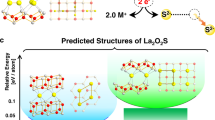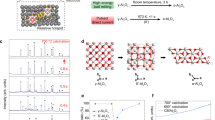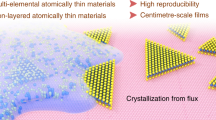Abstract
In the synthesis of inorganic materials, reactions often yield non-equilibrium kinetic byproducts instead of the thermodynamic equilibrium phase. Understanding the competition between thermodynamics and kinetics is a fundamental step towards the rational synthesis of target materials. Here, we use in situ synchrotron X-ray diffraction to investigate the multistage crystallization pathways of the important two-layer (P2) sodium oxides Na0.67MO2 (M = Co, Mn). We observe a series of fast non-equilibrium phase transformations through metastable three-layer O3, O3′ and P3 phases before formation of the equilibrium two-layer P2 polymorph. We present a theoretical framework to rationalize the observed phase progression, demonstrating that even though P2 is the equilibrium phase, compositionally unconstrained reactions between powder precursors favour the formation of non-equilibrium three-layered intermediates. These insights can guide the choice of precursors and parameters employed in the solid-state synthesis of ceramic materials, and constitutes a step forward in unravelling the complex interplay between thermodynamics and kinetics during materials synthesis.
This is a preview of subscription content, access via your institution
Access options
Access Nature and 54 other Nature Portfolio journals
Get Nature+, our best-value online-access subscription
$29.99 / 30 days
cancel any time
Subscribe to this journal
Receive 12 print issues and online access
$259.00 per year
only $21.58 per issue
Buy this article
- Purchase on Springer Link
- Instant access to full article PDF
Prices may be subject to local taxes which are calculated during checkout






Similar content being viewed by others
Data availability
All relevant data within the article are available from the corresponding author on request. Source data for the figures are provided with the paper.
References
Ong, S. P., Wang, L., Kang, B. & Ceder, G. Li-Fe-P-O-2 phase diagram from first principles calculations. Chem. Mater. 20, 1798–1807 (2008).
Andersson, J. O., Helander, T., Hoglund, L. H., Shi, P. F. & Sundman, B. THERMO-CALC & DICTRA, computational tools for materials science. Thermochemistry 26, 273–312 (2002).
Bianchini, M., Wang, J., Clément, R. & Ceder, G. A first-principles and experimental investigation of nickel solubility into the P2 NaxCoO2 sodium-ion cathode. Adv. Energy Mater. 8, 1801446 (2018).
Narayan, A. et al. Computational and experimental investigation for new transition metal selenides and sulfides: the importance of experimental verification for stability. Phys. Rev. B 94, 045105 (2016).
Sun, W. et al. The thermodynamic scale of inorganic crystalline metastability. Sci. Adv. 2, e1600225 (2016).
Aykol, M., Dwaraknath, S. S., Sun, W. & Persson, K. A. Thermodynamic limit for synthesis of metastable inorganic materials. Sci. Adv. 4, eaaq0148 (2018).
Gopalakrishnan, J. Chimie douce approaches to the synthesis of metastable oxide materials. Chem. Mater. 7, 1265–1275 (1995).
Stein, A., Keller, S. W. & Mallouk, T. E. Turning down the heat – design and mechanism in solid-state synthesis. Science 259, 1558–1564 (1993).
Chen, Y., Rangasamy, E., dela Cruz, C. R., Liang, C. & An, K. A study of suppressed formation of low-conductivity phases in doped Li7La3Zr2O12 garnets by in situ neutron diffraction. J. Mater. Chem. A 3, 22868–22876 (2015).
Wang, L. et al. Structure tracking aided design and synthesis of Li3V2(PO4)3 nanocrystals as high-power cathodes for lithium ion batteries. Chem. Mater. 27, 5712–5718 (2015).
Eriksson, R. et al. Formation of tavorite-type LiFeSO4F followed by in situ X-ray diffraction. J. Power Sources 298, 363–368 (2015).
Jensen, K. M. Ø., Tyrsted, C., Bremholm, M. & Iversen, B. B. In situ studies of solvothermal synthesis of energy materials. ChemSusChem 7, 1594–1611 (2014).
Shoemaker, D. P. et al. In situ studies of a platform for metastable inorganic crystal growth and materials discovery. Proc. Natl Acad. Sci. USA 111, 10922–10927 (2014).
Jiang, Z., Ramanathan, A. & Shoemaker, D. P. In situ identification of kinetic factors that expedite inorganic crystal formation and discovery. J. Mater. Chem. C. 5, 5709–5717 (2017).
Martinolich, A. J. & Neilson, J. R. Toward reaction-by-design: achieving kinetic control of solid state chemistry with metathesis. Chem. Mater. 29, 479–489 (2017).
Chen, B.-R. et al. Understanding crystallization pathways leading to manganese oxide polymorph formation. Nat. Commun. 9, 2553 (2018).
He, H. et al. Combined computational and experimental investigation of the La2CuO4–xSx (0 ≤ x ≤ 4) quaternary system. Proc. Natl Acad. Sci. USA 115, 7890–7895 (2018).
Kohlmann, H. Looking into the black box of solid-state synthesis. Eur. J. Inorg. Chem. 2019, 4174–4180 (2019).
Curtarolo, S. et al. The high-throughput highway to computational materials design. Nat. Mater. 12, 191–201 (2013).
Zunger, A. Inverse design in search of materials with target functionalities. Nat. Rev. Chem. 2, 0121 (2018).
Jain, A., Shin, Y. & Persson, K. A. Computational predictions of energy materials using density functional theory. Nat. Rev. Mater. 1, 15004 (2016).
Braconnier, J. J., Delmas, C., Fouassier, C. & Hagenmuller, P. Electrochemical behavior of the phases NaxCoO2. Mater. Res. Bull. 15, 1797–1804 (1980).
Lee, M. et al. Large enhancement of the thermopower in NaxCoO2 at high Na doping. Nat. Mater. 5, 537–540 (2006).
Takada, K. et al. Superconductivity in two-dimensional CoO2 layers. Nature 422, 53–55 (2003).
Delmas, C., Fouassier, C. & Hagenmuller, P. Structural classification and properties of the layered oxides. Phys. B+C. 99, 81–85 (1980).
Delmas, C., Fouassier, C. & Hagenmuller, P. Relative stability of octahedral and trigonal prismatic coordination in layered alkaline oxides AxMO2 (x less than or equal to 1). Mater. Res. Bull. 11, 1483–1488 (1976).
Parant, J. P., Olazcuaga, R., Devalette, M., Fouassier, C. & Hagenmuller, P. Sur quelques nouvelles phases de formule NaxMnO2 (x ⩽ 1). J. Solid State Chem. 3, 1–11 (1971).
Yabuuchi, N., Kubota, K., Dahbi, M. & Komaba, S. Research development on sodium-ion batteries. Chem. Rev. 114, 11636–11682 (2014).
Mo, Y., Ong, S. P. & Ceder, G. Insights into diffusion mechanisms in P2 layered oxide materials by first-principles calculations. Chem. Mater. 26, 5208–5214 (2014).
Guo, S. et al. Understanding sodium-ion diffusion in layered P2 and P3 oxides via experiments and first-principles calculations: a bridge between crystal structure and electrochemical performance. NPG Asia Mater. 8, e266 (2016).
Lei, Y. C., Li, X., Liu, L. & Ceder, G. Synthesis and stoichiometry of different layered sodium cobalt oxides. Chem. Mater. 26, 5288–5296 (2014).
Bianchini, M., Fauth, F., Hartmann, P., Brezesinky, T. & Janek, J. An in situ structural study on the synthesis and decomposition of LiNiO2. J. Mater. Chem. A 8, 1808–1820 (2020).
Delmas, C., Braconnier, J.-J., Fouassier, C. & Hagenmuller, P. Electrochemical intercalation of sodium in NaxCoO2 bronzes. Solid State Ion. 3, 165–169 (1981).
Avrami, M. Kinetics of phase change. I General theory. J. Chem. Phys. 7, 1103–1112 (1939).
Wang, L., Maxisch, T. & Ceder, G. A first-principles approach to studying the thermal stability of oxide cathode materials. Chem. Mater. 19, 543–552 (2007).
Richards, W. D., Miara, L. J., Wang, Y., Kim, J. C. & Ceder, G. Interface stability in solid-state batteries. Chem. Mater. 28, 266–273 (2016).
Takeda, Y., Akagi, J., Edagawa, A., Inagaki, M. & Naka, S. A preparation and polymorphic relations of sodium iron-oxide (NaFeO2). Mater. Res. Bull. 15, 1167–1172 (1980).
Fielden, R. & Obrovac, M. N. Investigation of the NaNixMn(1-x)O(2) (0 <= x <= 1) system for Na-ion battery cathode materials. J. Electrochem. Soc. 162, A453–A459 (2015).
Akimoto, J. et al. Single-crystal synthesis and structure refinement of Na0.44MnO2. Solid State Phenom. 170, 198–202 (2011).
Sun, W., Jayaraman, S., Chen, W., Persson, K. A. & Ceder, G. Nucleation of metastable aragonite CaCO3 in seawater. Proc. Natl Acad. Sci. USA 112, 3199–3204 (2015).
Sun, W., Kitchaev, D. A., Kramer, D. & Ceder, G. Non-equilibrium crystallization pathways of manganese oxides in aqueous solution. Nat. Commun. 10, 573 (2019).
Navrotsky, A. Nanoscale effects on thermodynamics and phase equilibria in oxide systems. ChemPhysChem 12, 2207–2215 (2011).
Ma, X. et al. Guiding synthesis of polymorphs of materials using nanometric phase diagrams. J. Am. Chem. Soc. 140, 17290–17296 (2018).
Sun, J., Ruzsinszky, A. & Perdew, J. P. Strongly constrained and appropriately normed semilocal density functional. Phys. Rev. Lett. 115, 036402 (2015).
Blangero, M. et al. High-temperature phase transition in the three-layered sodium cobaltite P’3-NaxCoO2 (x similar to 0.62). Phys. Rev. B 77, 18 (2008).
Stoyanova, R. et al. Stabilization of over-stoichiometric Mn4+ in layered Na2/3MnO2. J. Solid State Chem. 183, 1372–1379 (2010).
Kumakura, S., Tahara, Y., Kubota, K., Chihara, K. & Komaba, S. Sodium and manganese stoichiometry of P2-type Na2/3MnO2. Angew. Chem. Int. Ed. 55, 12760–12763 (2016).
Rodriguez-Carvajal, J. Recent advances in magnetic-structure determination by neutron powder diffraction. Phys. B 192, 55–69 (1993).
Hohenberg, P. & Kohn, W. Inhomogeneous electron gas. Phys. Rev. 136, B864–B871 (1964).
Kresse, G. & Furthmüller, J. Efficiency of ab-initio total energy calculations for metals and semiconductors using a plane-wave basis set. Comput. Mater. Sci. 6, 15–50 (1996).
Blöchl, P. E. Projector augmented-wave method. Phys. Rev. B 50, 17953–17979 (1994).
Kitchaev, D. A. et al. Energetics of MnO2 polymorphs in density functional theory. Phys. Rev. B 93, 045132 (2016).
Yang, J. H., Kitchaev, D. A. & Ceder, G. Rationalizing accurate structure prediction in the meta-GGA SCAN functional. Phys. Rev. B 100, 035132 (2019).
Togo, A. & Tanaka, I. First principles phonon calculations in materials science. Scr. Mater. 108, 1–5 (2015).
Linstrom, P. J. and Mallard, W. G. NIST Chemistry WebBook NIST Standard Reference Database Number 69 (NIST, 2018); https://doi.org/10.18434/T4D303
Kaufman, J. L. & Van der Ven, A. NaxCoO2 phase stability and hierarchical orderings in the O3/P3 structure family. Phys. Rev. Mater. 3, 015402 (2019).
Acknowledgements
Funding for this study was provided by the US Department of Energy, Office of Science, Basic Energy Sciences, under contract No. UGA-0-41029-16/ER392000 as a part of the Department of Energy Frontier Research Center for Next Generation of Materials Design: Incorporating Metastability, and supported by the Samsung Advanced Institute of Technology. This work used the 28-ID‐2 (XPD) beamline of the National Synchrotron Light Source II (NSLS-II), a US Department of Energy (DOE) Office of Science User Facility operated for the DOE Office of Science by Brookhaven National Laboratory under contract No. DE‐SC0012704. Work conducted at the Cornell High Energy Synchrotron Source (CHESS) is supported by the National Science Foundation under award No. DMR-1332208. Work at the Advanced Photon Source (APS) at Argonne National Laboratory was supported by the US Department of Energy, Office of Science, Office of Basic Energy Sciences under contract No. DE-AC02-06CH11357. The TEM characterizations were performed at the Molecular Foundry, Lawrence Berkeley National Laboratory (LBNL), supported by the Office of Science, Office of Basic Energy Sciences, of the US Department of Energy under contract No. DE-AC02-05CH11231. We acknowledge W. Xu for the assistance at APS and A. Toumar for discussion and support with SCAN calculations.
Author information
Authors and Affiliations
Contributions
W.S. and G.C. initiated and supervised the project. M.B. and J.W. designed the experiments. J.W. conducted synchrotron-based measurements with the help of T.S., M.Z., J.B., F.W. and H.K. M.B. and J.W. performed XRD data analysis and Rietveld refinement. R.J.C. and B.O. conducted DFT and reaction energy calculations and analysed the results with the help of D.K. R.J.C. constructed the finite-temperature phase diagram. P.X. carried out the solid-state nudged elastic band calculation. Y.Z. acquired the TEM and EDS data. Y.W. performed phonon frequency calculations. W.S. conceived and calculated the energy cascade with the help of J.W.. M.B., J.W., W.S. and G.C. wrote the manuscript.
Corresponding authors
Ethics declarations
Competing interests
The authors declare no competing interests.
Additional information
Publisher’s note Springer Nature remains neutral with regard to jurisdictional claims in published maps and institutional affiliations.
Supplementary information
Supplementary Information
Supplementary Figs. 1–17, Notes 1–4 and Table 1.
Source data
Source Data Fig. 1
DFT calculations.
Source Data Fig. 2
XRD dataset, Rietveld refinement results.
Source Data Fig. 3
DSC dataset.
Source Data Fig. 4
DFT calculations, elemental distribution TEM.
Source Data Fig. 5
Reaction energy calculations.
Source Data Fig. 6
Reaction energy calculations.
Rights and permissions
About this article
Cite this article
Bianchini, M., Wang, J., Clément, R.J. et al. The interplay between thermodynamics and kinetics in the solid-state synthesis of layered oxides. Nat. Mater. 19, 1088–1095 (2020). https://doi.org/10.1038/s41563-020-0688-6
Received:
Accepted:
Published:
Issue Date:
DOI: https://doi.org/10.1038/s41563-020-0688-6
This article is cited by
-
Navigating phase diagram complexity to guide robotic inorganic materials synthesis
Nature Synthesis (2024)
-
Optimal thermodynamic conditions to minimize kinetic by-products in aqueous materials synthesis
Nature Synthesis (2024)
-
Autonomous and dynamic precursor selection for solid-state materials synthesis
Nature Communications (2023)
-
Prediction of Van Hove singularity systems in ternary borides
npj Computational Materials (2023)
-
An autonomous laboratory for the accelerated synthesis of novel materials
Nature (2023)



